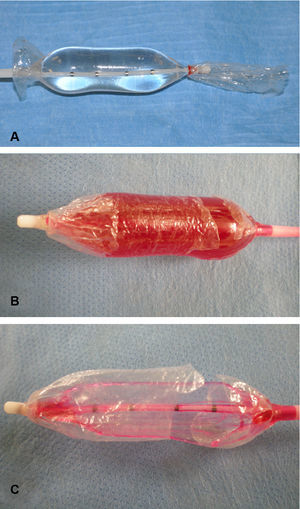To the Editor,
The bursting of an expansion balloon is a relatively frequent complication in interventional cardiovascular procedures.1,2 Bursting can be suspected when the balloon loses its original shape or leakage of the contrast medium is observed. A complete rupture can lead to the embolization of material to distal structures. A partial rupture can impede the proper withdrawal of the balloon and, in addition, can produce effects that result in the obstruction of the blood flow due to the horizontal expansion of the material.
We present the case of a 10-year-old girl with a congenital heart defect consisting of transposition of the great vessels with a ventricular septal defect and pulmonary stenosis, initially corrected by closure of the defect and implantation of a conduit from the right ventricle to the pulmonary artery. During follow-up, we observed progressive stenosis of the conduit, with right ventricular dysfunction, which made her a candidate for percutaneous pulmonary valve implantation.
In accordance with international guidelines, a bare metal stent was inserted in the conduit and, subsequently, the pulmonary valve was implanted without complications. In order to ensure the proper fit of the valve to the conduit, the latter was redilated with the aid of an 18-mm Mullins balloon at a pressure of up to 11 atm (burst pressure, according to the manufacturer, 12 atm). After deflation, we detected desaturation and bradycardia, despite the fact that the balloon was completely deflated. The oxygen saturation and heart rate normalized only when the balloon was placed in inferior vena cava. A second redilation produced satisfactory results with respect to diameter, but the desaturation and bradycardia reappeared when the balloon was deflated, and only improved when the balloon was placed in inferior vena cava.
Subsequently, we proceeded to withdraw the balloon completely and observed that, indeed, the balloon had burst (Figure 1A), but in a peculiar way, in that the rupture only appeared in a thin outer layer, as though the device were a balloon-in-balloon catheter (Figure 1B). Thus, the angiographic study revealed the normal shape of an inflated balloon (Figure 1C) when, in reality, there was an outer layer that had an “umbrella-like” effect on the outflow tract and impeded the flow of the blood toward the lungs, a leading to desaturation and bradycardia. Only by removing the balloon from the outflow tract was it possible to improve the hemodynamic status of the patient.
Figure 1. A: aspect of the balloon after being withdrawn from the patient; the outer layer is folded back, a finding somewhat similar to the results that would be obtained with the rupture of a balloon-in-balloon catheter. B: in vitro simulation of the burst balloon when expanded; note the proper dilatation, with maintenance of the shape. C: in vitro simulation of the deflated balloon; no contrast material is observed in the interior, but the outer layer remains expanded, producing an umbrella effect.
The Mullins balloon is a very high-pressure dilatation balloon. Its laminated structure, an improvement over the initial versions that became commercially available, make it softer and more collapsible, with no sharp edges once deflated. This laminated structure is probably the cause of the partial rupture that led our patient to the situation described here.
Corresponding author: georgia@brugada.org


